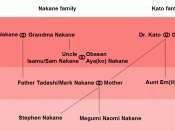Hitler, a fanatic in almost everyone's book, has killed and tortured millions during the years he led Germany; however, this does not mean all Germans are fanatics, so why were the Japanese-Canadians ostracized in Canada during and after World War II? Racism and racial conflict have caused great turmoil all over the world for centuries; events such as the Holocaust are very well know but the dark past of Canada is not. In the time of our grandfathers during and after World War II the Japanese-Canadians were being mistreated by the white Canadians and the Canadian government. In Joy Kogawa's novel Obasan, Ms. Kogawa tells us the story of Naomi's family through a series of letters written by her Obasan, which means "Aunt" in English. The theme of Ms. Kogawa's novel was racism and she portrayed what the Japanese-Canadians went through using animals, insects and Aunt Emily's documents and letters.
Throughout Obasan there were several occasions where Ms. Kogawa had animals in situations similar to what the Japanese-Canadians had to deal with after World War II. In one part of the novel there is a kitten trapped underneath an outhouse, "the kitten cries day after day, not quite dead, unable to climb out and trapped in the outhouse. The maggots are crawling in its eyes and mouth. Its fur covered in feces" (172) describes what the white Canadians did to the Japanese-Canadians. The Canadian government tried to get rid of the Japanese-Canadians by sending them to concentration camps and ghost towns, the outhouse in the imagery, and ignored the letters of protest that they received, like the cats mewing. By sending the Japanese away the, government was hoping the Japanese-Canadian community would be forgotten and diminish. Another form of animal imagery that Ms. Kogawa uses is the hen and...


